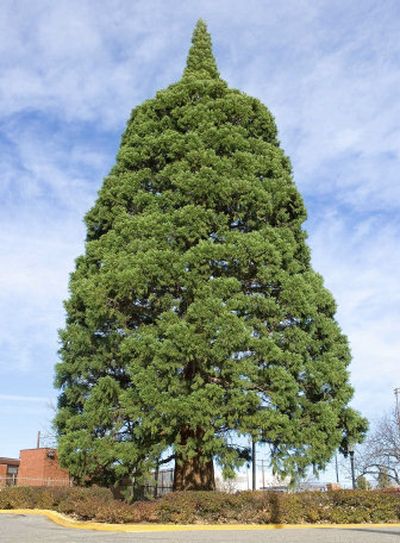Tree hunters stump for champions

BOISE – Idaho turns out to be fertile ground for big tree hunters.
Waves of immigrants brought cuttings and seeds to the state to plant trees that reminded them of home. A century later, some of those trees have found their way into the state record books along with native species. The state even has 11 national champions.
The most recent state champion is a non-native giant sequoia on the grounds of St. Luke’s Regional Medical Center in Boise.
“About a year ago, I was driving by and went, ‘Whoa,’ ” said big tree hunter Tim Kennedy, of Boise, a forestry specialist with the Idaho Department of Lands who watches for possible champions.
The tree at St. Luke’s is not especially tall at 89 feet, having lost its original top because of damage from Christmas decorations in the 1980s. But its base is 18 feet around, which helped it in the formula that determines champions.
Big tree hunters measure height, base circumference, and the tree’s crown spread to come up with a total points score. When Kennedy measured the St. Luke’s tree, it scored 318 points, easily toppling the former champion at the University of Idaho Arboretum in Moscow.
The tree at St. Luke’s is a youngster in sequoia time at less than a century old. Some giant sequoias in California, where the species occurs naturally, are more than 2,000 years old.
Like many city trees, the St. Luke’s sequoia has a known history. It was planted in 1912 in the yard of one of the doctors who worked at the hospital, said Holly Miller, internal communications coordinator for the hospital.
Boise has about 30 more giant sequoias scattered in city parks, said Jerry Stallsmith, the city forester.
“They grow anywhere from three to six foot a year,” he said.
Ron Mahoney, a forestry professor at the University of Idaho and director of Idaho’s Big Tree Program, said sequoias do well in the state. So do many other species of trees, based on the variety found in many Idaho cities.
“A lot of people think that where we find things occurring naturally is where their best environment must be, and there’s really not much basis for that,” said Mahoney. “We’ve had a lot of natural disasters over the years – glaciers, volcanoes, floods – and species get moved around.”
People, too.
“Most of the people in Idaho came here from somewhere else, and they brought trees to bring a little bit of their home with them,” Mahoney said. “An awful lot of them are the eastern deciduous species – the oaks, walnuts, and hickories.”
But the largest tree in Idaho is a native, a massive western red cedar near the town of Elk River east of Moscow. A state champion, it is 177 feet tall and 56 feet around at its base. In big tree hunter numbers, it scores 867 points.
The conservation group American Forests, based in Washington, D.C., tracks national champions with its National Register of Big Trees. All of Idaho’s national champion trees are natives, Mahoney said.
The largest Idaho national champion tree is an Engelmann spruce in the Lowman Ranger District in Boise County. It scored 486 points.
“People are fascinated by really large specimens,” said Mahoney. “We have a lot of champions that are not big, but are big for their species. When you get to the trees that really get big, it’s an amazing thing.”
Mahoney said more state champions are out there, and perhaps even a few more national champions.
“One year we replaced the champion ponderosa pine twice because of forest fires,” Mahoney said. “Some of the champions are enduring and last a long time. But there’s still room to find more.”